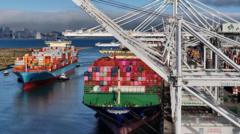In a notable escalation of trade tensions, US President Donald Trump has officially enforced new tariffs affecting more than 90 countries worldwide. As the deadline for trade negotiations lapsed, Trump took to his Truth Social platform to declare that billions of dollars were now benefiting the United States due to these import taxes.
The primary objective behind these tariffs is to revive American jobs and manufacturing sectors in line with Trump's broader political ambitions. Among Trump's recent moves, he threatened to ramp up tariffs on imports from India to 50% if the country continues purchasing Russian oil, and hinted at a staggering 100% tariff on foreign-produced computer chips to incentivize tech investments domestically.
This approach reflects Trump's vision to redefine the global trading landscape, which he believes has disproportionately disadvantaged the US. One of his pledges upon returning to the presidency was to reduce the trade deficit, the gap between American imports and exports, using tariffs to impose taxes on goods from abroad—costs that may eventually be passed on to consumers.
The new tariffs, first announced in April but delayed due to market instability, have been met with mixed reactions. Economies in Southeast Asia, particularly export-driven ones like Laos and Myanmar, have been hit hardest, facing tariffs as high as 40%. Experts have noted that Trump's strategy seems targeted at countries with strong trade ties with China. Despite the turbulent backdrop, Asian markets reacted moderately, with some indexes rising, suggesting an adjustment to the new reality.
Amid the chaos, some major economies—including the UK, Japan, and South Korea—managed to secure agreements that provide lower tariff rates than initially proposed. The European Union has also brokered a framework arrangement, resulting in a 15% tariff on its goods exported to the US. In contrast, Switzerland now faces one of the highest rates at 39%.
For Taiwan, a crucial US ally in Asia, the tariff rate reached 20%, with officials indicating ongoing discussions with the White House.
Additionally, Trump's trade policies target key partners like Canada and Mexico, where tariffs have fluctuated amid ongoing negotiations related to the United States-Mexico-Canada Agreement (USMCA). Recently, Trump elevated the tariff on Canada from 25% to 35% due to what he describes as insufficient action against cross-border drug trafficking.
Further complicating matters, Trump has made it clear that he intends to penalize nations linked to Russia, announcing secondary tariffs that could impact Moscow’s trade allies unless a ceasefire in Ukraine is reached soon. On Wednesday, he reiterated his focus on India, threatening significant tariff increases unless it halts oil imports from Russia—an ultimatum that India's government quickly termed “unfair” and “unreasonable”.
Amidst these developments, tech giant Apple, under pressure from the administration, unveiled plans for a $100 billion investment in the US, showcasing the links between tariffs and corporate strategy. Certain key semiconductor manufacturers may be shielded from the impending tariffs, as government officials from Taiwan and South Korea have indicated exemptions for major players.
As the ramifications of Trump's tariffs unfold, the international community is closely observing how these policies will reshape both economic landscapes and diplomatic relations in the coming months.
The primary objective behind these tariffs is to revive American jobs and manufacturing sectors in line with Trump's broader political ambitions. Among Trump's recent moves, he threatened to ramp up tariffs on imports from India to 50% if the country continues purchasing Russian oil, and hinted at a staggering 100% tariff on foreign-produced computer chips to incentivize tech investments domestically.
This approach reflects Trump's vision to redefine the global trading landscape, which he believes has disproportionately disadvantaged the US. One of his pledges upon returning to the presidency was to reduce the trade deficit, the gap between American imports and exports, using tariffs to impose taxes on goods from abroad—costs that may eventually be passed on to consumers.
The new tariffs, first announced in April but delayed due to market instability, have been met with mixed reactions. Economies in Southeast Asia, particularly export-driven ones like Laos and Myanmar, have been hit hardest, facing tariffs as high as 40%. Experts have noted that Trump's strategy seems targeted at countries with strong trade ties with China. Despite the turbulent backdrop, Asian markets reacted moderately, with some indexes rising, suggesting an adjustment to the new reality.
Amid the chaos, some major economies—including the UK, Japan, and South Korea—managed to secure agreements that provide lower tariff rates than initially proposed. The European Union has also brokered a framework arrangement, resulting in a 15% tariff on its goods exported to the US. In contrast, Switzerland now faces one of the highest rates at 39%.
For Taiwan, a crucial US ally in Asia, the tariff rate reached 20%, with officials indicating ongoing discussions with the White House.
Additionally, Trump's trade policies target key partners like Canada and Mexico, where tariffs have fluctuated amid ongoing negotiations related to the United States-Mexico-Canada Agreement (USMCA). Recently, Trump elevated the tariff on Canada from 25% to 35% due to what he describes as insufficient action against cross-border drug trafficking.
Further complicating matters, Trump has made it clear that he intends to penalize nations linked to Russia, announcing secondary tariffs that could impact Moscow’s trade allies unless a ceasefire in Ukraine is reached soon. On Wednesday, he reiterated his focus on India, threatening significant tariff increases unless it halts oil imports from Russia—an ultimatum that India's government quickly termed “unfair” and “unreasonable”.
Amidst these developments, tech giant Apple, under pressure from the administration, unveiled plans for a $100 billion investment in the US, showcasing the links between tariffs and corporate strategy. Certain key semiconductor manufacturers may be shielded from the impending tariffs, as government officials from Taiwan and South Korea have indicated exemptions for major players.
As the ramifications of Trump's tariffs unfold, the international community is closely observing how these policies will reshape both economic landscapes and diplomatic relations in the coming months.



















